
Defining "Decluttering Progress" And How To Avoid The Shuffling Around Clutter Trap
Use this definition of decluttering progress to make sure you continue to head to your ultimate goal, a clutter free house, and avoid the trap of shuffling around your clutter.
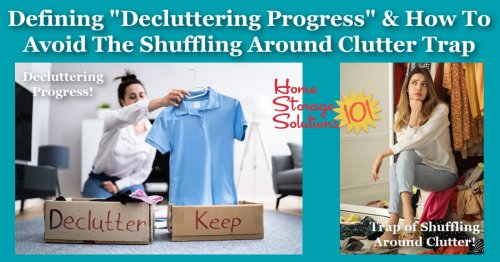
I'm often asked, what do I think are the biggest mistakes to avoid when decluttering your home?
I've thought a lot about this question, and I've come up with two answers. The first of the big mistakes is not actually starting the decluttering process at all, perhaps from a feeling of overwhelm, or not feeling like you even know where or how to begin. (The whole method of decluttering in small steps, using the Declutter 365 missions as a guide, is my solution to help you avoid this big mistake.)
But even after you start decluttering, there is a second big mistake that you need to avoid, to see decluttering success in your home, and that's the topic I want to discuss in this article in more detail.
The second big mistake to avoid when decluttering your home is wasting time and energy shuffling stuff around, instead of making what I call true "decluttering progress."
When Shuffling Around Clutter Happens
Shuffling around clutter happens anytime you find yourself doing one or more of the following:
- Moving stacks or piles around, from one location to another
- Looking through items without making decisions about what is and is not clutter
- Trying to prettify piles of stuff, or just organize everything you've got
The thing that happens in all these scenarios, where you're shuffling clutter, is that in none of them does the total volume of "stuff" in your house decrease with time. Instead, with all these scenarios you're keeping it all, and moving it around from spot to spot, trying different ways to organize it, or store it, or make it all fit.
In some ways, this second mistake, which I term falling into the “shuffling around clutter trap,” is even worse than the first, because shuffling around clutter exhausts you without any positive results to show for your efforts, and that can be quite demoralizing and make you give up for good.
I want you to avoid this shuffling around clutter trap, and I've found that the simplest way to do this is help you understand what true decluttering progress is, and what it looks like in practice. This helps you realize, much more quickly, when you accidentally fall into this trap, and to know the simple steps to free yourself and get back on track.
So, let's start with the concept of what "decluttering progress" is.
What Is Decluttering Progress?
One of the mindsets that I believe is essential to adopt to find decluttering success is to strive for "progress, not perfection."
Seeking perfection is a fool's errand, because it is impossible to attain. No one and no home can ever be perfect. That means striving for perfection is striving for something that can never happen.
Seeking perfection often leads to paralysis of action, because we think if it can't be perfect, it's not worth doing anything at all. Since we want to have a bias for action when doing the Declutter 365 method of decluttering we have to let go of those perfectionist tendencies.
But since we're learning, sometimes over and over again, that perfection is not worth striving for, what does the other part of that saying, "progress, not perfection" really mean? How do you define "progress," when decluttering your home?
Taylor's definition of decluttering progress:
Decluttering progress happens when clutter is regularly, and consistently, leaving your home.
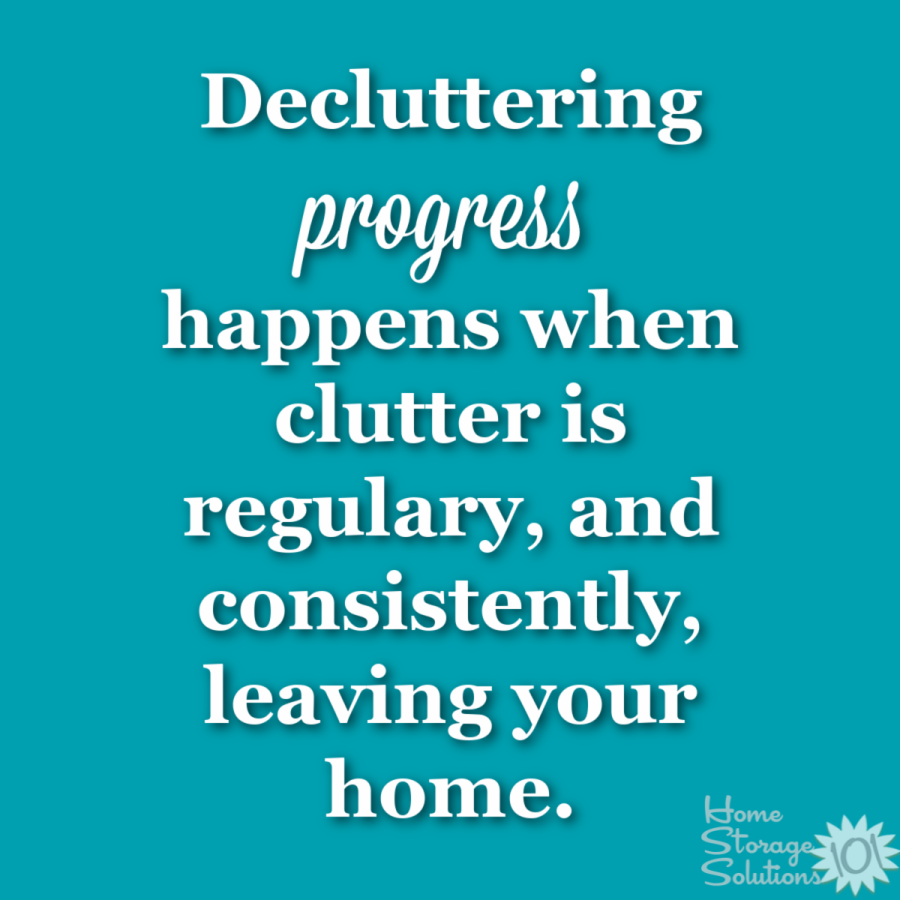
I know, that definition sounds obvious. It really is, but somehow it is still sometimes hard to grasp (trust me, I had to work a long time to do so!). However, it's when we don't grasp the definition that we're most likely to fall into the trap of shuffling around our clutter.
So let me explain that a bit more.
Analogy: Your Home Is A Cup, And Stuff Is The Liquid Filling It Up
Think of your home as a cup, and the stuff in your home as the liquid that fills the cup.
It's nice to have some liquid in your cup, so you have something to drink. Similarly, it's nice to have some stuff in your home. After all, you need some stuff to live reasonably well.
While some liquid in your cup is good, you can easily get too much liquid filling your cup, such as when it is filled almost or totally to the brim. Then, suddenly it's much harder to carry your cup around. In that situation the liquid may slosh and spill over as you move, making life harder than it needs to be as you have to move more carefully and slowly around, and periodically stop to clean up the mess if you accidentally spill a bit here or there.
If your home has so much stuff it's almost full, you may not always have a problem, but it can make life a bit harder some or all of the time. For example, you have to slow down, looking for something you've lost in the piles, or when a pipe leaks under your kitchen sink lots of stuff gets ruined because you didn't realize the leak was happening for a long time, because so much stuff was in the way.
Now, back to our cup analogy. What if your cup isn't just pretty full, or even filled to the brim, but instead your cup continues to get filled even further, to the point that it overflows. Now, it's not just hard to carry your cup around, it is also a mess everywhere you look, and you're trying constantly to sop up the mess all around you, all the time, without any breaks.
This can happen in your home when there is more stuff than places to put it all away. You laugh at the idea of "everything in its place" because it's all just overflowing from the cabinets, drawers, and shelves, and has filled up the flat surfaces and perhaps the floor too. Now your stuff isn't just slowing you down sometimes, but constantly, from tripping hazards on the floor, no flat surfaces available for spreading out a project, or perhaps not even a place to sit on the couch because of the unfolded laundry.
I like to use this analogy because it helps us understand why we can feel like, once we've reached above a certain threshold of stuff, we suddenly feel like it's too much. It helps us understand that the stuff that was, before, in small amounts, a good and useful thing, becomes above that threshhold a burden which slow us down, makes accidents more likely, or even causes chaos in our lives.
The analogy also shows how simple and yet transformative the solution to the problem is. We've got to remove some of the liquid from the cup to stop the overflow, and further to lower the liquid level past the point of overly full so it's easier to carry around.
So when all signs point that you've got too much stuff for your container (your home), the answer is that it's time to get rid of some of it to get back to a nicely filled, but not overflowing or too full house. That's when you need decluttering progress -- i.e., for stuff to regularly and consistently be leaving your home.
Avoiding The Trap Of Shuffling Your Clutter
So using the analogy of the house as a cup, and stuff as the liquid, when you fall into the trap of shuffling around your clutter you're basically swirling around the liquid contents of your cup, and then wondering why it isn't getting less full (and you might even be making a bigger mess with your swirling efforts than if you'd left it alone).
Instead of swirling around the liquid, it's time to remove excess liquid from your cup, even if it's a drop at a time, and eventually you're going to make everything easier and easier on yourself.
Similarly, instead of shuffling the clutter around your home, get rid of it.
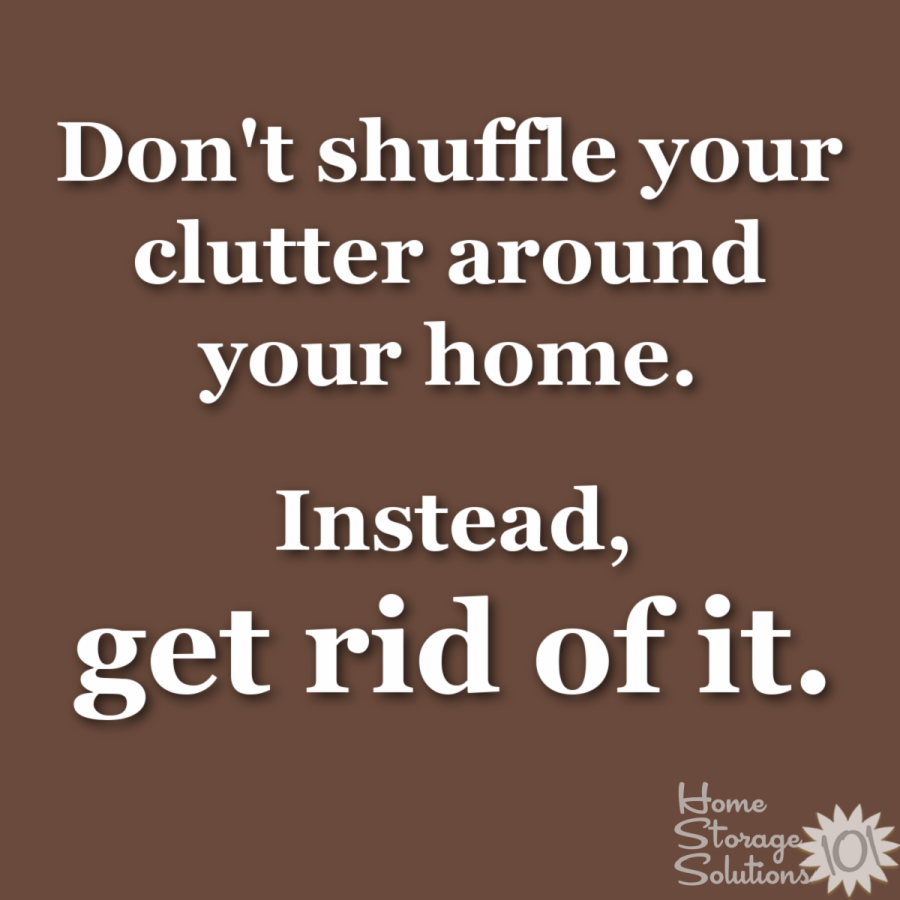
"Get rid of it" is something I want you to repeat to yourself over and over, as you identify clutter. If something really is clutter in your home, you cannot and should not try to organize it. If it's clutter, it shouldn't be in your house at all.

Practically What Progress Looks Like When Decluttering
So then, what practically does decluttering progress look like?
You know you're making decluttering progress when examples like these are happening in your home:
- There's an extra bag or two of trash in your trash can this week;
- You have a small box that you drive to the donation center;
- You sell something in a local buy/sell group, and the seller comes to pick it up, or you drop it off, or ship it out
Remember that “It’s not 100% decluttered until it leaves your home.”
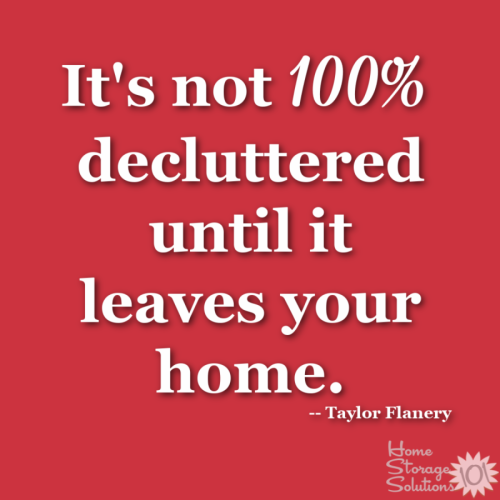
The trick is to look for the stuff leaving your home, consistently and routinely.
Sometimes, when you've got a lot of stuff to deal with these small trickles of stuff out don’t seem like they're making a dent, and you feel like you're not making progress, but that is a common misconception. Instead, you can feel better knowing that you're dealing with your clutter, one small drop removed at a time.
How The Declutter 365 Missions Are Designed To Make Sure You Make Decluttering Progress
Each week, as part of the Declutter 365 missions, I have you work on identifying various types of clutter in your home, and then to make sure you're making actual decluttering progress, and getting it 100% decluttered, I also have a series of missions, generally once a week, on Saturdays typically, that make sure you do that final step of the decluttering process, which is to make sure that the clutter you've identified actually leaves your home by donating, selling, or trashing/recycling it.
You can see an example of that in the image, which is showing you typical Saturday missions in the yearly Declutter 365 calendar.
(If you haven't already, you can get your FREE yearly Declutter 365 calendar here, at this link on the site.)
I repeat this mission, week after week, in some form or fashion, within this Declutter 365 system, because this is a step that needs to be done regularly and consistently, otherwise the clutter stays piled up in your home, and if that happens you're still stuck in the trap of just shuffling it around.
That's why it's important to repeat these "get rid of your clutter" missions, to get the clutter all the way out of your home, as often as necessary to make sure you continue to make progress.
Don't allow the donations to sit undonated for too long, or to never have that yard sale, or to leave the trash piled up but not taken to the dump.
If you start to notice too many of these last steps to complete, stop identifying more clutter with new Declutter 365 missions for a while, and devote as many 15 minute sessions as necessary toward getting rid of the stuff you already have determined is clutter, getting it completely out of your home. You can check out the general clear the clutter mission here, to complete the decluttering process.

I want you to take that last step to 100% complete the decluttering process, and when you do you will make actual decluttering progress.
Remember, reduce the total amount of liquid, even by a drop or two, regularly, in your cup. Don't just keep swirling it around!
You Can Get More Decluttering Tips For Your Home!
I hope this article has helped you learn how to avoid the trap of shuffling around clutter, so you can start to make actual progress with your efforts. I've got a whole lot more decluttering tips here.

If You Haven't Already, Join The Daily Declutter 365 Missions & Get Started Today!
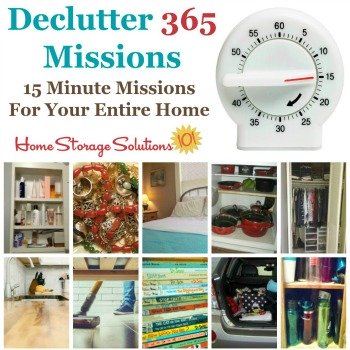
If you haven't already, make sure to get your copy of this year's Declutter 365 annual calendar here (it's FREE!), find today's date, and do 15 minutes of decluttering on the day's mission.
It will be your first step toward decluttering your whole house!

Some links on this page are affiliate links, meaning that if you purchase a product through them I receive a small commission which helps me provide this information to you for free, plus support my family. My integrity and your satisfaction are very important to me so I only recommend products I would purchase myself, and that I believe would benefit you. To learn more please see my disclosure statement.
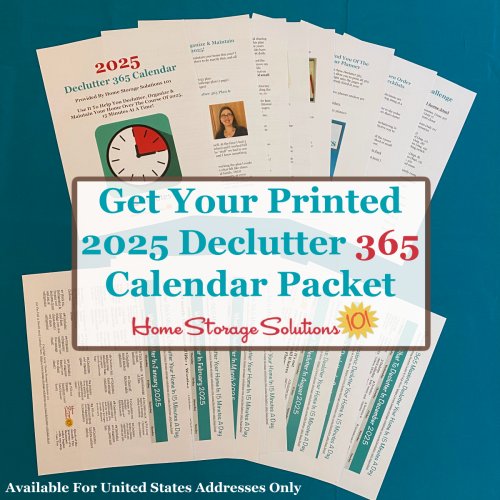
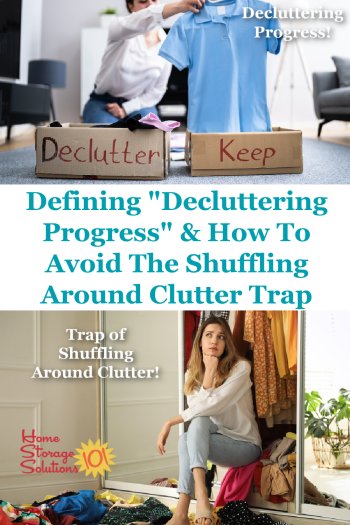
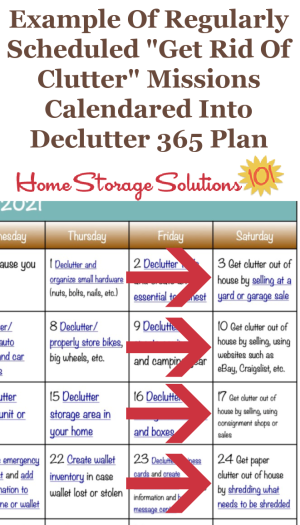
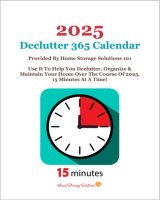
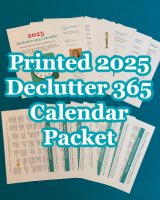
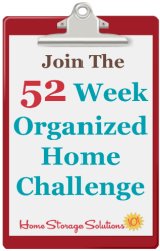



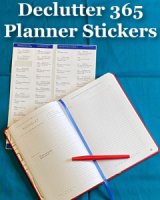







Share Your Comments, Tips & Ideas
I would love to hear from you, sharing your thoughts, questions, or ideas about this topic, so leave me a comment below. I try to always respond back!